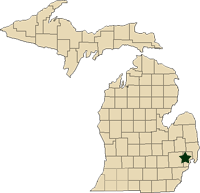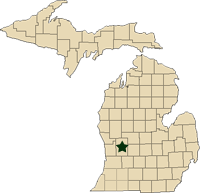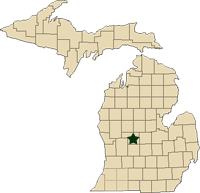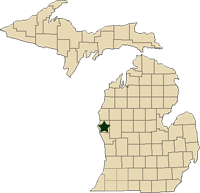Regional reports on Michigan vegetables – August 3, 2011
MSU Extension educators’ pest and vegetable updates for Michigan.
This week’s regional reports:
- East Michigan (Lapeer, Macomb, St. Clair) – Hannah Stevens
- Grand Rapids Area – Bill Steenwyk
- Central Michigan – Fred Springborn
- West Central Michigan – Norm Myers
East Michigan (Lapeer, Macomb, St. Clair) – Hannah Stevens, Michigan State University Extension
|
Field conditions
Four rain events since last week’s reports amounted to 1.6 to over 4 inches across the region and, in some areas, included heavy downpours. While the moisture was needed, it has complicated harvest activities and brought mosquitoes out in force. High temperatures ranged from 80°F to over 90, but on the average it has been cooler than the previous weeks.
Crop conditions
Growers are moving into the second sweet corn plantings which are now mature. Corn earworm counts are twice that of last week, but western bean cutworm trap catches are down in Macomb. European corn borer numbers are up slightly.
Cooler temperatures have apparently favored the dispersal and development of downy mildew on cucumbers and it can be found now in Macomb County on farms and gardens and very likely throughout the region. There is a heavy crop of slicers and pickles, and it is extremely important to maintain adequate coverage and spray intervals.
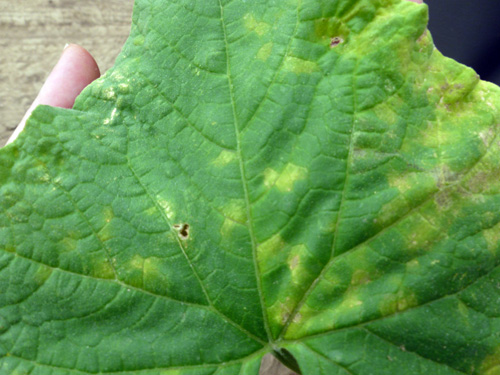
Downy mildew on top of leaf.
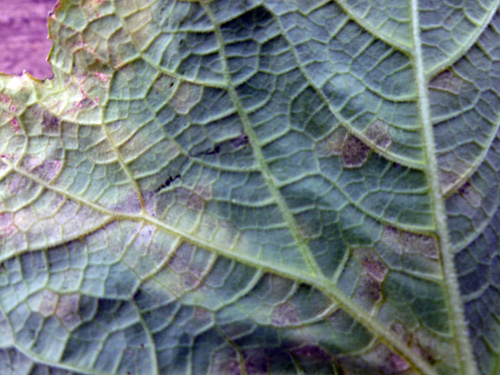
Downy mildew on bottom of leaf.
The watermelon crop looks like it will be excellent. Dry and dusty conditions have favored two-spotted spider mite development on this and other vegetables, including eggplants. Check the undersurface of the leaf for webbing, tiny black spots and the mites themselves, visible with a hand lens.
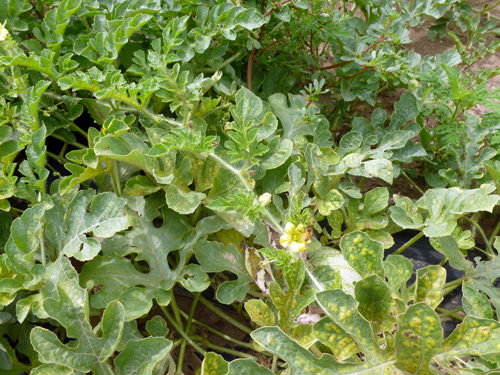
Two-spotted spider mite injury.
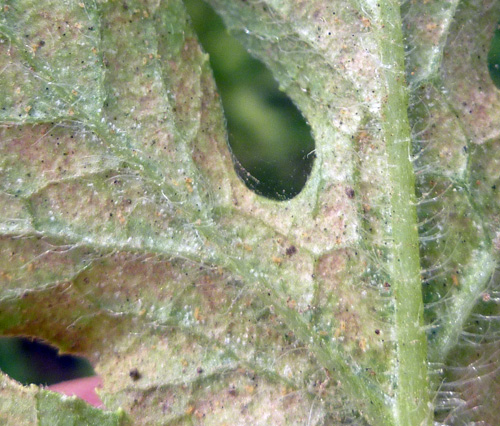
Close up of two-spotted spider mite injury.
Muskmelons are nearing harvest, perhaps this week. Cabbage butterflies (imported cabbage worm) are on the flowers of many crops seeking nectar, and cole crop growers need to be watchful.
On tomatoes there is some blossom end rot, particular on the more susceptible plum tomatoes, but bell peppers are also showing symptoms of this as well as some sunscald.
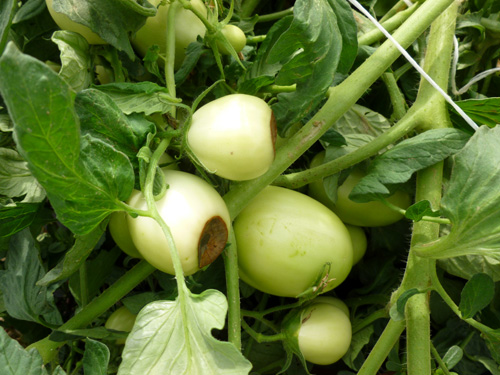
Blossom end rot.
Grand Rapids Area – Bill Steenwyk, Michigan State University Extension
|
Hot, humid and wet sums up the weather in the Grand Rapids area for the past seven days. Daytime highs were in the mid-80s to low 90s. Nights have been warm as well. Rainfall was moderate to excessive. MSU Enviro-weather stations recorded 3 to 6 inches of rainfall in portions of Kent and Allegan counties. Most of this fell last Wednesday and Thursday, July 27-28. Most other areas received 1 to 2 inches. In the wetter areas, field work has been challenging, with some pest control products being applied by plane or helicopter.
Onions continue to develop, with leaf fall beginning on the earliest crop. Damage from thrips is light to moderate in many areas. Disease pressure is rising, with purple blotch being most frequently reported, along with some botrytis. In the wettest areas, crop losses have occurred.
Celery harvest continues. Yields have been fair to good, although as with onions, some losses have occurred in areas that experienced excessive rainfall. Variegated cutworms have been a problem for some, and aphid populations are on the rise. Spider mites are present in modest numbers, as are aster leafhoppers. Two of four leafhopper samples analyzed last week were positive for aster yellows infectivity.
Sweet corn harvest is underway and reports remain positive overall. My pheromone traps show rising numbers of European corn borer moths, with a 0-1-9 count for the three traps. A five- to seven-day spray interval is recommended. I was unable to collect corn earworm trap data. A local scout also reports rising numbers of European corn borer moths. Only a few western bean cutworm moths were detected.
The summer squash harvest is underway. Grower reports are positive overall. Most of the pepper and tomato crop appears to be good, although sunscald on peppers is a problem for some (Photo 1). Some tomato late blight is also evident.
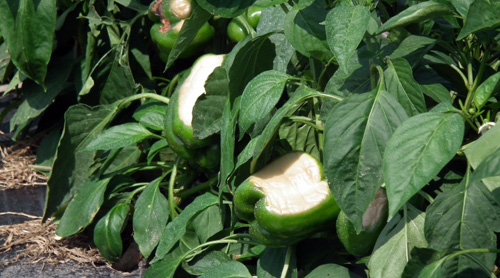
Photo 1. Sunscald on peppers.
Potatoes are growing well, although Colorado potato beetles and flea beetles are challenges in some fields.
Carrots and parsnips are growing well overall, despite being about two weeks behind in development due to the very cool weather earlier this season.
Mint is now being harvested and distilled into oil (Photo 2). The crop has grown well.
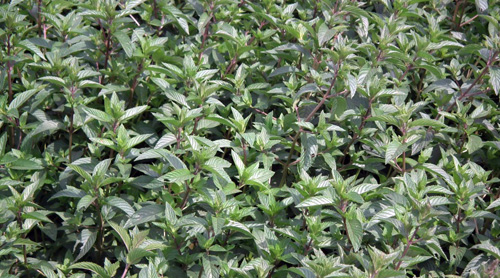
Photo 2. Mint ready for harvest.
Central Michigan – Fred Springborn, Michigan State University Extension
|
High temperatures this week were in the mid- to upper 80s with lows in 60s. Rain showers over the last eight days have given some relief to many drought stressed areas in the central region. Totals from last week’s storm ranged from 0.9 inches in northern Mecosta County to 5-plus inches in some areas of Montcalm.
Harvest of pickling cucumber is well underway. Fruit has been growing rapidly in the very warm temperatures we have experienced. There are additional downy mildew reports this week.
Western bean cutworm moth flight and egglaying is winding down. Pheromone traps in Montcalm are still catching 5 to 10 moths per night, down from 100-plus per night in some traps. New egg masses can still be found in pre-tasseled field corn and likely can be found in pre-tasseled sweet corn. Egglaying has more than likely shifted to dry beans and other common beans over the last week to 10 days as field corn matures into pollination and beyond, and has become less attractive for egglaying. Growers of sweet corn should continue to scout plantings that are in the pre-tassel stage, especially if a regular insecticide schedule is not being used for other pests such as corn ear worm or European corn borer.
Western bean cutworm egg masses are typically deposited on the upper leaves of corn plants and normally hatch in five to seven days. The young larvae then move to the emerging or newly emerged tassel and leaf axils to feed on pollen, and then move to the silks before entering the ear. It is also important to note that not all types of Bt will control western bean cutworm; the cry1A protein found in some varieties of sweet corn will provide excellent control of European corn borer, but will not provide control of western bean cutworm.
For more information on western bean cutworms, see related articles below.
- Western bean cutworms are active in sweet corn, MSU Department of Entomology Zsofia Szendrei
- Western bean cutworm update for August 2, 2011, MSU Department of Entomology Chris DiFonzo and MSU Extension Fred Springborn
- Western bean cutworm update for July 25, 2011, MSU Department of Entomology Chris DiFonzo and MSU Extension Fred Springborn
West Central Michigan – Norm Myers, Michigan State University Extension
|
Weather continued hot and dry this week. Some rain did fall, especially in the western and southern parts of the county, where totals ranged from 0.8 up to 2 inches in several rains (as of August 2). The main vegetable growing belt is still quite dry and irrigators are very busy keeping up with crop demands.
Foliar diseases on asparagus have remained under control in spite of the nearly ideal disease conditions. That is largely because of MSU plant pathologist Mary Hausbeck’s Tom-Cast disease forecasting system, which has been nearly universally accepted by our local asparagus industry as a tool to managed disease.
Vine crops are also under disease pressure. Powdery mildew arrived early this year and you can find a little of it in most squash fields. I have had no new virus samples brought to me, so watermelon mosaic virus seems to be our only problem on that front. Yields of processing zucchini have been light this year and many people blame poor pollination, even where adequate colonies of bees have been brought in to the area.
In carrots, the leafhopper index in Oceana County has been down for two consecutive weeks. We are now using 30/100 sweeps as the new threshold based on those tests. Scouts report finding very few leafhoppers. With heat and irrigation, disease pressure is also high in carrots. Again, most people are using Tom-Cast as their guide for putting on preventative sprays.
I did not catch any European corn borer moths, but did get one corn earworm moth. I also caught six western bean cutworms in my sweet corn trap, but had 57 in my field corn trap.
Early plantings of snap beans are being harvested now. I have had no reports of insect problems in that crop.
Processing broccoli continues to grow, but stands are thin, especially in the early plantings.



 Print
Print Email
Email